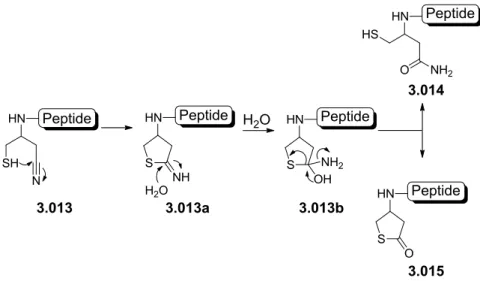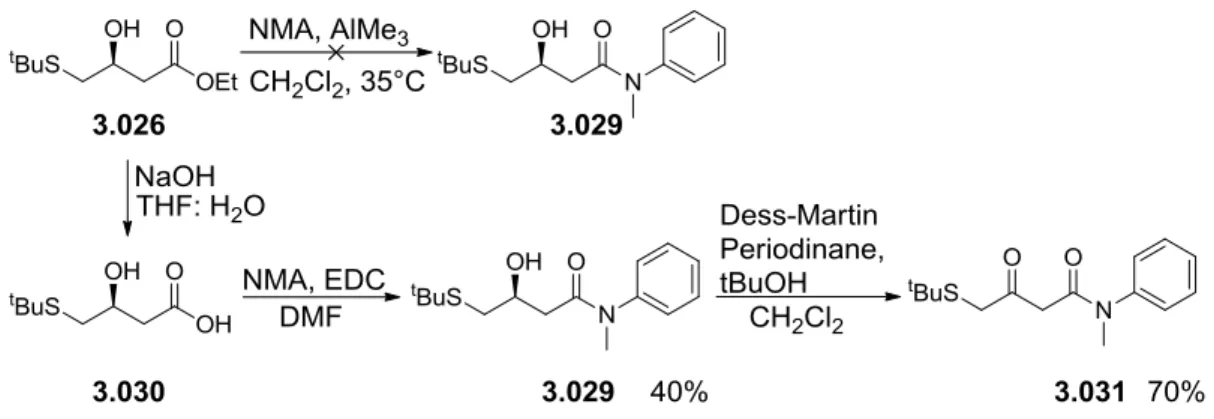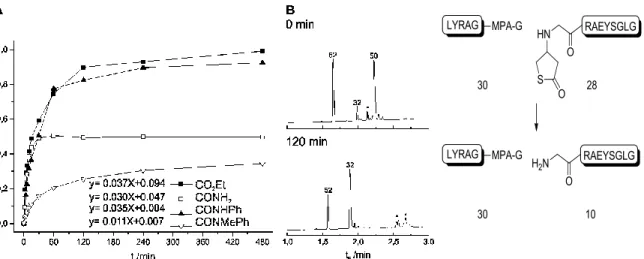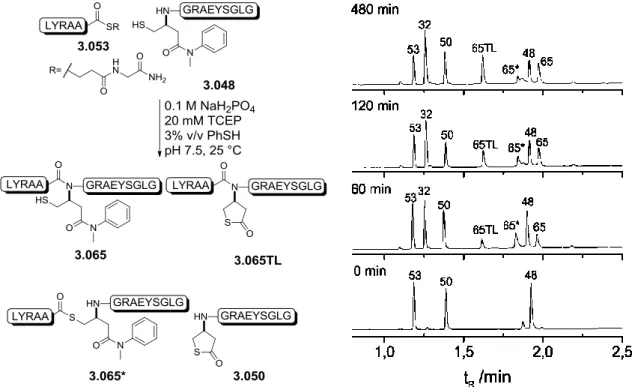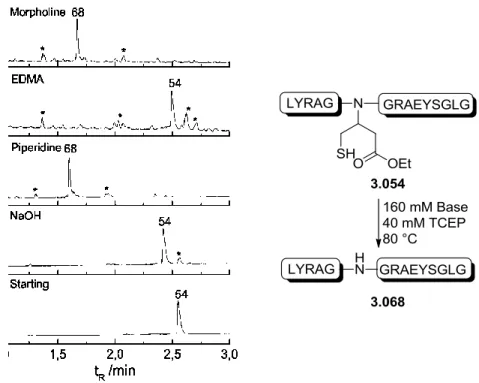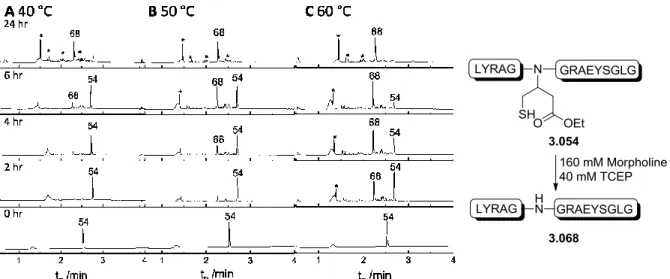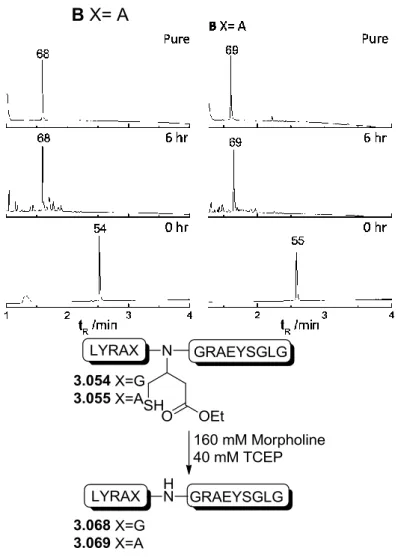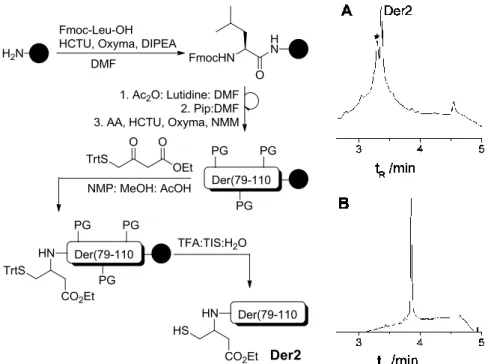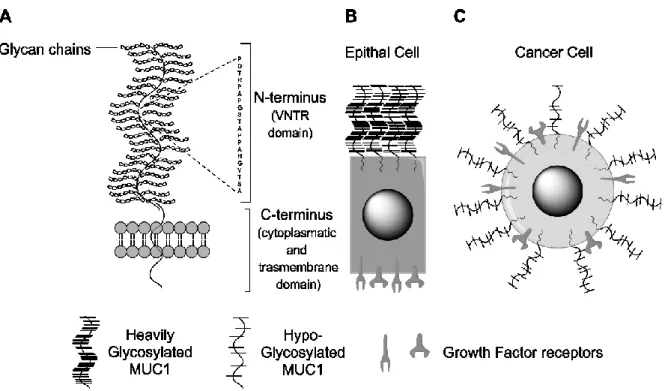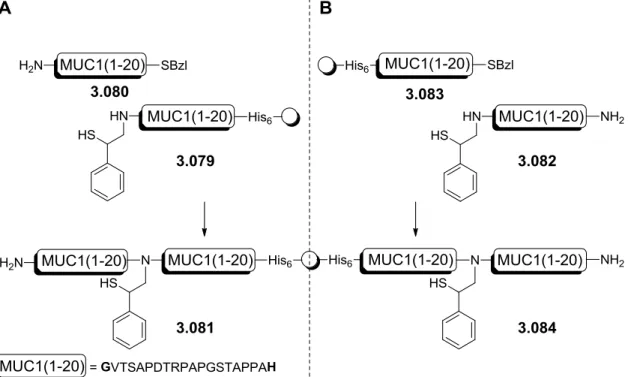Basenlabile Auxiliare für die Erweiterung der
Native Chemische Ligation in Lösung und an der Festphase
D ISSERTATION
zur Erlangung des akademischen Grades doctor rerum naturalium
(Dr. rer. nat.)
Im Fach Chemie mit Spezialisierung in Organischer und Bioorganischer Chemie
Eingereicht an der
Mathematisch-Naturwissenschaftlichen Fakultät der Humboldt-Universität zu Berlin
von
M.Sc Ziv Harpaz
Präsident der Humboldt-University zu Berlin:
Prof. Dr. Jan-Hendrik Olbertz
Dekan der Mathematisch-Naturwissenschaftlichen Fakultät:
Prof. Dr. Elmar Kulke
Gutachter/innen: 1. Prof. Dr. Oliver Seitz
2. Prof. Dr. Christian P. R. Hackenberger
Tag der mündlichen Prüfung: 19. November 2015
Base-Labile Auxiliaries for Extending
Native Chemical Ligation in Solution and Solid Phase
D ISSERTATION
in partial fulfillment of the requirements for the academic degree of doctor rerum naturalium
(Dr. rer. nat.)
in Chemistry with specialization in Organic and Bioorganic Chemistry
Submitted to
The Faculty of Mathematics and Natural Sciences Humboldt University of Berlin
by
M.Sc Ziv Harpaz
President of the Humboldt University of Berlin:
Prof. Dr. Jan-Hendrik Olbertz
Decant of the Faculty of Mathematics and Natural Sciences:
Prof. Dr. Elmar Kulke
Referees: 1. Prof. Dr. Oliver Seitz
2. Prof. Dr. Christian P. R. Hackenberger
Thesis Defense held on: 19
thof November 2015
Selbstständigkeit Dekleration/ Independance Declaration
Ich erkläre, dass ich die Dissertation selbständig und nur unter Verwendung der von mir gemäß § 7 Abs. 3 der Promotionsordnung der Mathematisch-Naturwissenschaftlichen Fakultät, veröffentlicht im Amtlichen Mitteilungsblatt der Humboldt-Universität zu Berlin Nr. 126/2014 am 18.11.2014 angegebenen Hilfsmittel angefertigt habe.
Ich habe mich nicht anderwärts um einem Doktorgrad im Promotionsfach Chemie beworben und besitze keinen Doktorgrad im Promotionsfach Chemie.
Die Promotionsordnung der Mathematisch-Naturwissenschaftlichen Fakultät, veröffentlicht im Amtlichen Mitteilungsblatt der Humboldt-Universität zu Berlin Nr. 126/2014 am 18.11.2014 habe ich zur Kenntnis genommen.
I declare that I have produced this doctor’s thesis independently using only the tools I have specified, in accordance with section 7 paragraph 3 of the Faculty of Mathematics and Natural Sciences PhD regulations, published in the Official Gazette of Humboldt-Universität zu Berlin (Amtliches Mitteilungsblatt) no. 126/2014 on 18/11/2014.
I have not applied for a doctoral degree in the doctoral subject of Chemistry elsewhere and do not hold a doctoral degree in the doctoral subject of Chemistry.
I have taken due note of the Faculty of Mathematics and Natural Sciences PhD Regulations, published in the Official Gazette of Humboldt-Universität zu Berlin (Amtliches Mitteilungsblatt) no. 126/2014 on 18/11/2014.
Table of Contents
Schemes Index ... v
Figures Index ... vii
Acknowledgments ... ix
1 Introduction ... 11
1.1 Proteins and Protein Synthesis
... 11
1.2 Protein Synthesis through Ligation Methods
... 12
1.2.1 Native Chemical Ligation (NCL)
... 13
1.2.2 Extending Native Chemical Ligation
... 14
1.2.3 Traceless Staudinger Ligation
... 22
1.2.4 Ketoacid Hydroxylamine Ligation
... 23
1.2.5 Solid Phase Chemical Ligation (SPCL)
... 24
2 Research Goals ... 29
3 Results and Discussion ... 33
3.1 Native Chemical Ligation Assisted by Base-Labile Auxiliaries
... 33
3.1.1 Initial Concept and Design of the Auxiliaries
... 33
3.1.2 Synthesis of Auxiliary Peptides
... 34
3.1.3 Ligation Experiments
... 44
3.1.4 Removal of Auxiliary
... 53
3.1.5 Changing the Thiol Protecting Group for Improved Protecting Groups Chemistry
.... 59
3.1.6 Total Chemical Synthesis of DCD-1L
... 61
3.1.7 Conclusions
... 65
3.2 Synthesis of MUC1 Protein by Auxiliary-Assisted Solid Phase Chemical Ligation
... 67
3.2.1 Concept and Introduction
... 67
3.2.2 The MUC1 Protein
... 68
3.2.3 Choice of Polymer Support
... 69
3.2.4 Synthesis of Peptide Fragments for the C→N and N→C directed SPCL
... 70
3.2.5 Attaching the peptides to the polymer support
... 73
3.2.6 Auxiliary Assisted SPCL on Ni-NTA Resin
... 74
3.2.7 Auxiliary Removal from ligation product
... 75
3.2.8 Efforts towards Sequential Auxiliary-Assisted SPCL
... 76
3.2.9 Auxiliary-Assisted SPCL of a 80mer VNTR MUC1 Peptide
... 84
3.2.10 Auxiliary-mediated SPCL Conclusions
... 88
4 Summary and Outlook ... 91
4.1 Summary
... 91
4.2 Outlook
... 99
5 Experimental Part ... 101
5.1 Instruments and Materials
... 101
5.2 General Methods
... 102
5.3 Experimental Data for NCL Assisted by Base-Labile Auxiliary
... 109
5.3.1 Synthesis of Auxiliary Precursors
... 109
5.3.2 Synthesis of Model Peptides
... 113
5.3.3 Reductive Amination on Solid Support
... 115
5.3.4 tert-Butyl Protecting Group Removal
... 115
5.3.5 Auxiliary-Assisted Native Chemical Ligations:
... 118
5.3.6 Removal of Auxiliary
... 127
5.3.7 Total synthesis of DCD-1L
... 128
5.4 Experimental Data for Auxiliary-Assisted SPCL
... 130
5.4.1 Synthesis of Auxiliary Precursor 2-((bis(4-methoxyphenyl) (phenyl) methyl)thio)-2- phenylacetaldehyde (3.072)
... 130
5.4.2 SPPS, Preparation of peptide building blocks and Chromatographic Purification of Proteins and Peptides
... 130
5.4.3 Auxiliary-Assisted SPCL in N→C and C→N direction
... 132
5.4.5 Total Chemical Synthesis of MUC1(1-80)-His6
... 134
References ... 136
Appendix A: Spectrometry Data ... 145
A.1 NMR Spectra
... 145
A.2 UPLC-MS Analysis
... 155
Appendix B: List of Abbreviations ... 167
mehcSes xedcI
Scheme 1.1 ... 2
Scheme 1.2 ... 13
Scheme 1.3 ... 14
Scheme 1.5 ... 16
Scheme 1.6 ... 17
Scheme 1.7 ... 19
Scheme 1.8 ... 20
Scheme 1.9 ... 22
Scheme 1.10 ... 23
Scheme 1.11 ... 24
Scheme 1.14 ... 28
Scheme 2.1 ... 30
Scheme 2.2 ... 31
Scheme 3.1 ... 34
Scheme 3.2 ... 34
Scheme 3.3 ... 35
Scheme 3.4 ... 36
Scheme 3.5 ... 36
Scheme 3.6 ... 36
Scheme 3.7 ... 37
Scheme 3.8 ... 37
Scheme 3.9 ... 38
Scheme 3.10 ... 42
Scheme 3.11 ... 50
Scheme 3.12 ... 51
Scheme 3.13 ... 56
Scheme 3.14 ... 60
Scheme 3.15 ... 62
Scheme 3.16 ... 68
Scheme 3.17 ... 71
Scheme 3.18 ... 76
Scheme 3.19 ... 77
Scheme 1.4 ... 15
Scheme 1.12 ... 26
Scheme 1.13 ... 27
Scheme 4.2 ... ...96
Scheme 4.3 ... ...97
Scheme 4.1 ...91
Scheme 3.20 ... 79
Scheme 3.21 ... 81
Figures Index
Figure 3.1 ... 35
Figure 3.2 ... 38
Figure 3.3 ... 40
Figure 3.4 ... 41
Figure 3.5 ... 44
Figure 3.6 ... 45
Figure 3.7 ... 46
Figure 3.8 ... 47
Figure 3.9 ... 48
Figure 3.10 ... 49
Figure 3.11 ... 50
Figure 3.12 ... 54
Figure 3.13 ... 55
Figure 3.14 ... 57
Figure 3.15 ... 57
Figure 3.16 ... 58
Figure 3.17 ... 59
Figure 3.18 ... 60
Figure 3.19 ... 61
Figure 3.20 ... 63
Figure 3.21 ... 64
Figure 3.22 ... 65
Figure 3.23 ... 69
Figure 3.24 ... 70
Figure 3.25 ... 71
Figure 3.26 ... 72
Figure 3.27 ... 73
Figure 3.28 ... 74
Figure 3.29 ... 75
Figure 3.30 ... 76
Figure 3.31 ... 78
Figure 3.32 ... 80
Figure 3.33 ... 81
Figure 3.34 ... 82
Figure 3.35 ... 82
Figure 3.36 ... 83
Figure 3.37 ... 85
Figure 3.38 ... 86
Figure 3.39 ... 87
Figure 3.40 ... 87
Figure 4.1 ... 92
Figure 4.2 ... 93
Figure 4.3 ... 94
Figure 4.4 ... 95
Figure 4.5 ... 95
Figure 4.6 ... 96
Figure 4.7 ... 98
Figure 5.1 ... 115
Figure 5.2 ... 116
Figure 5.3 ... 119
Figure 5.4 ... 119
Figure 5.5 ... 120
Figure 5.6 ... 120
Figure 5.8 ... 121
Figure 5.9 ... 121
Figure 5.10 ... 122
Figure 5.11 ... 122
Figure 5.12 ... 123
Figure 5.13 ... 123
Figure 5.14 ... 124
Figure 5.15 ... 124
Figure 5.16 ... 125
Figure 5.17 ... 125
Figure 5.18 ... 125
Figure 5.19 ... 126
Figure 5.20 ... 126
Figure 5.21 ... 127
Figure 5.22 ... 127
Figure 5.23 ... 128
Figure 5.24 ... 129
Acknowledgments
Firstly, I would like to express my sincere gratitude to my advisor Prof. Dr. Oliver Seitz, for offering a place in your team, for the continuous support during my PhD study, for his motivation, and immense knowledge. His guidance helped me in all the time of research and writing of this thesis.
Secondly, a special thank goes to Simon Loibl who collaborated with me on these projects and his suggestions, ideas and motivation have helped to successfully complete the project. For their helpful and insightful corrections and suggestions to my Thesis I thank Dr. Josephine Schmalisch and Simon Loibl. Dr. Ramon Subiros Funosas and Robert Zitterbart also deserve my sincere appreciations for the helpful advices and discussions. My sincere thanks also goes to my labmates Dr. Alex Roloff, Dr. Melanie Fischbach, Dr. Julia Michaelis and Pablo Lores Lareo for the stimulating discussions, for the nice atmosphere working together, for teaching me German and showing me Berlin. For all the fun we have had in the last five years in and out of the lab. I also thank the rest of the wonderful people in the group for support, good advice and good times together.
Other people who helped make the last 5 years meaningful, interesting and productive are Dr.
Rajnish Rao, Saša Bodiroža, Smadar Ovadia-Caro and Mike Ludwig.
Last but not the least, I would like to thank my family: my parents Nili and Chen Harpaz, my sisters Galit Harpaz-Yaniv and Zohar Fenigstein my Aunts Shulamit Persky and Drora Persky and all members of my family for supporting me spiritually throughout the Ph.D and writing this thesis and my life in general.
11
1 Introduction
1.1 Proteins and Protein Synthesis
Proteins are the most abundant biological macromolecule and exhibit enormous diversity of biological function ranging from enzymes, hormones, antibodies and transporters to building block and crucial components in organs such as muscle fibers, cytoskeleton or cell membrane. Proteins are the most important products of the genetic information pathway and are omnipresent in all life forms from viruses through single cell bacteria and up to the most complex multi-cellular organisms. They are of major interest in the biomedical, pharmaceutical and material science fields and study of proteins has always been of great interest to the scientific community [1].
The study of proteins requires acquiring homogenous samples of defined composition, which are then used to determine the structure and function of the protein molecule. Once an understanding of the structure and function of individual protein molecules has been achieved, system-wide studies can be carried out to investigate how proteins interact with one another in the context of the proteome.
Nowadays, preparation of proteins is achieved using two main approaches: biological methods to express proteins and total chemical synthesis of proteins.
Current methods in molecular biology typically start with recombinant DNA expression, isolation and purification of a target protein. The structure of the target protein is then systematically varied by modern molecular biology techniques, and the effects of these changes are evaluated by a wide variety of methods aimed to gather new information such as binding affinities, post translation modification, or catalytic mechanisms. Proteins obtained via these methods are restricted to biological constrains, requiring special techniques to allow insertion of unnatural amino acids or modification [2]. Moreover, proteins go through post translational modifications in the cell and proteins of the same sequence can exhibit different modifications, making the protein sample heterogeneous and thus, study of the protein is highly restricted or in severe cases cannot be conducted at all.
Chemical synthesis of proteins is advantageous over the biological methods as it allows total control over the protein sequence. Unnatural amino acids may be incorporated into the sequence selectively [3, 4], acting as probes for structure and function or for therapeutic purposes [5-7].
Moreover, any post translational modification can be introduced in a highly selective manner and in high yields. The previous years have seen development of several chemical ligation methods based on different chemical reactions such as click chemistry[8], oxime ligation[9], traceless Staudinger ligation[10, 11] or ketoacid-hydroxylamine (KAHA) ligation[12]. In the field of chemical synthesis of proteins, chemical ligation methods that rely on acyl-transfer and form the native peptide bond have been established as the paradigm for synthesis.
12
1.2 Protein Synthesis through Ligation Methods
Solid phase peptide synthesis (SPPS), introduced in 1963 in the pioneering, ground breaking work of Merrifield [13] is still the method of choice for peptide synthesis. Despite major advancements and optimization in polymer supports, reagents, and automation of the method, SPPS is effective for the synthesis of polypeptide chains of only several dozen residues in length (depending on sequence) [14] due to the accumulation of resin-bound byproducts of incomplete coupling reactions. A number of works have been published presenting impressive synthesis of longer polypeptides using only sequential SPPS but the process is long, tedious, expensive and wasteful (due to multi-coupling steps, use of expensive activators and repetitive washing steps) with low isolated yields [15, 16]. To overcome this limitation, chemical ligation strategies have been developed for the total chemical synthesis of proteins [17]. Chemical ligation enables chemoselective conjugation of two peptide fragments to yield a single defined product. Due to the insolubility of long protected polypeptides, modern chemical ligation methods are performed in aqueous buffers using unprotected peptide fragments to give a larger polypeptide chain in a chemoselective manner (scheme 1.1A). In the early stages, the necessity for chemoselectivity resulted in ligation that formed unnatural bonds such as thioesters, thioether, oxime or thiazolidine [17-20] between the two peptide fragments (scheme 1.1B).
Scheme 1.1: A) Principle of chemical ligation of unprotected peptide fragments; B) non-native chemical ligation bonds. 1.004: thioester, 1.005: thioether, 1.006: oxime, 1.007: thiazolidine.
The obvious drawback of the previously described ligation methods was the formation of an unnatural bond at the ligation site forming an unnatural mutation on the target which could limit its study for biological purposes. One of the early successful attempts to ligate two peptides yielding a native peptide bond was achieved by Kemp through prior thiol capture (scheme 1.2) [21]. The method relies on a rigid template based on dibenzofurane equipped with a thiol handle, attached to the peptide C-terminus (1.008). In the thiol capture step the disulfide intermediate 1.010 was formed, followed by O→N acyl transfer to yield the ligation product 1.011 which is reduced to the unmodified ligation product 1.012. The disadvantage is the slow reaction rate due to the medium ring size formed during the acyl transfer (12 member ring), and the poorly reactive C-terminal ester.
13 Scheme 1.2: Peptide synthesis by prior thiol capture.
1.2.1 Native Chemical Ligation (NCL)
In 1994, Kent and co-workers developed a new chemical ligation method titled "native chemical ligation" (NCL). Similar to an observation reported by Wieland [22], NCL enabled the formation of the native peptide bond at the ligation junction [23]. NCL involves a terminal C- thioester and a N-terminal cysteinyl peptide. The mechanism comprises two steps: the thioester undergoes a reversible nucleophilic attack by the side chain thiol moiety of the N-terminal cysteine residue followed by spontaneous S→N acyl transfer through a five membered ring transition state, to form a native peptide bond (scheme 1.3). NCL is accomplished in presence of all functional groups present in proteins, in aqueous buffer at neutral pH and ambient temperature. Notably, the chemoselectivity is achieved even in the presence of additional cysteine residues as the formed thioester is reversible and unproductive. Seitz and co-workers have even shown that the presence of internal cysteine residues can accelerate the ligation rate [24, 25]. The first application of NCL was demonstrated by the full chemical synthesis of human interleukine-8 (IL-8), a 72-amino acid chemokine containing four Cys residues. [23].
14 Scheme 1.3: Proposed Mechanism of NCL
1.2.2 Extending Native Chemical Ligation
The requirement of a cysteine residue at the ligation junction is an intrinsic limitation of NCL.
Cysteine has low frequency in sequences which is estimated to be 1.3% [26]. Some proteins lack cysteine residues entirely, others do not have a cysteine residue at a synthetically beneficial position, and are therefore synthetically inaccessible by NCL. These limitations prompted the development of various methods that seek to extend the high efficiency of NCL.
1.2.2.1 Conformationally Assisted Ligation
The native chemical ligation of two peptides is achieved by the chemoselective reaction between a cysteine and a C-thioester in denaturing conditions. An interesting approach titled
“conformationally assisted ligation” [27] takes advantage of the native tertiary structure of a protein to bring the N-terminal and the C-thioester into close proximity. This allows for the direct attack of the amine on the thioester, eliminating the necessity of the transthioesterification step, and thus, making the cysteine residue at the N-terminal obsolete. Dawson and co-workers demonstrated the effectiveness of the method through the synthesis of Chymotrypsin Inhibitor 2 (CI2), a 64-amino acid protein lacking any cysteine residues making it inaccessible for synthesis via NCL. Early studies have demonstrated that the fragment CI(1-40) of CI2 binds a second fragment CI(41-64) to form a stable protein with a tertiary structure similar to that of the native protein. Initial studies using standard NCL were performed by altering the sequence of the peptide fragments. CI2(1-39)T39D-COSR and CI2(40- 64)M40C were synthesized and reacted under ligation condition to give the full CI2 within 8 hr. When
15 the modified peptide fragments were reacted under folding conditions, the ligation was complete in only 30 min. Ligation under folding conditions proceeded rapidly (30 min) even when the sterically hindered native threonine thioester CI2(1-39)-COSR was used. In comparison, under denaturizing conditions the same ligation required 48 hr to complete. Next, the native CI2(1-39) and CI2(40-64) were ligated. Expectedly, under denaturizing conditions no product formation was detected. When performed under folding conditions product was formed within 2 hr, demonstrating the importance of conformationally induced effective molarity for ligation.
1.2.2.2 Thioalkylation and Ligation at Serine Junction
Thioalkylation enables ligation to take place at methionine ligation junctions. In this approach homocysteine (HCY) is introduced into the sequence in place of methionine mimicking the cysteine function in NCL (1.017). Following ligation, the HCY is methylated to reform the native methionine 1.019 in the sequence (scheme 1.4A) [28]. Methionine, however, is not common in sequences[26], reducing the applicability for protein synthesis. Moreover, if other cysteine residues are present, protection is needed to avoid alkylation of these residues. By using different alkylation reagents the method can also be used for forming unnatural amino acids at the ligation site such as thiolysine 1.020 [29], thioglutamine 1.021 [29] or thioglutamate1.022 [30] (scheme 1.4B). The method could also be applied to introduce a serine residue at the ligation site by converting the cysteine upon reaction with cyanobromide to a depsipeptide that subsequently rearranges to form the serine-containing peptide [31]
(
scheme 1.4C)
.Scheme 1.4: Extending NCL using thioalkylation. A) Ligation at methionine; B) Thioderivatives of amino acids; C) Insertion of serine at ligation junction following methionine ligation.
16 1.2.2.3 Desulfurization
Desulfurization is a frequently applied method used to convert cysteine to alananine after NCL. The concept has been extended to amino acids beyond alanine. For this purpose, an amino acid bearing a thiol handle at its or carbon is required. Following ligation, desulfurization of the thiol handle converts the amino acid into the natural amino acid in the protein sequence (scheme 1.5A).
Scheme 1.5: A) Principle of ligation-desulfurization B) Proposed mechanism for free-radical desulfurization.
The method was introduced by Yan and Dawson, who used it to perform ligation at alanine [32]. During synthesis, alanine was replaced by a cysteine and NCL was performed. Following ligation, the cysteine residue was reduced using Raney Nickel to yield the native alanine residue. The application of this approach was demonstrated initially in the synthesis of the cyclic antibiotic microcin J25, the 56-amino acid streptococcal protein G B1 domain and a variant of the 110-amino acid ribonuclease, barnase [32]. The Raney nickel used to induce desulfurization proved incompatible with several functional groups, causing epimerization at threonine and reduction of thioethers and thioesters [33]. A new metal-free desulfurization method was later developed by Danishefsky and co- workers based on a free-radical mechanism compatible with all native functional groups present on peptides (except other cysteine residues that must be protected to avoid desulfurization) [33]. The proposed mechanism involves a desulfurization reaction between sulfhydryl and trialkylphosphine derivatives. A thiyl radical reacts with phosphine, thereby generating an intermediate phosphoranyl radical. Subsequent scission was envisioned to provide an alkyl radical, and rapid hydrogen abstraction from the parent thiol would furnish the product alkane, thereby serving to propagate the chain (scheme 1.5B). Since its introduction the method gained high popularity and numerous amino acids modified with a thiol handle were developed. Nowadays ligation-desulfurization has been demonstrated with phenylalanine [34, 35], valine [33, 36], threonine [37], lysine [38, 39], leucine [40, 41], proline [42, 43], glutamine [44], glutamic acid [45] aspartic acid [46], tryptophan [4] and arginine [47] junctions.
The method is not without its hindrances though. For one, excluding alanine, γ-proline and penicillamine (ligation at valine) which are commercially available, all of the modified amino acids
17 must be specifically synthesized. Another disadvantage is the necessity to temporarily protect other cysteine residues to avoid unwanted desulfurization. Thirdly, the ligation product needs to be purified before desulfurization can be performed, as the aryl thiol additives used as catalysts in ligations are excellent radical scavengers and therefore hinder the radical reaction. In recent years several groups have addressed these problems. The group of Brik has used a mercaptophenylacetic acid (MPAA) derivative containing a hydrazine moiety that was removed from the ligation buffer by passing the solution through an aldehyde resin. Desulfurization was sequentially performed without prior HPLC purification [48]. Payne and co-workers have recently demonstrated one-pot ligation-desulfurization using a new thiol additive- trifluoroethanethiol. This highly volatile thiol can be bubbled out of the ligation solution allowing desulfurization to occur [35, 49]. The same group has also published a very interesting study describing one-pot ligation-desulfurization of β-mercaptoaspartic acid without harming other cysteine residues in the sequence, thus avoiding extra protecting group chemistry manipulation and repetitive purification steps [46]. Desulfurization method is credited to some of the most ambitious accomplishments in the field of total chemical synthesis of proteins such as Danishefsky synthesis of the EPO protein [50] or synthesis of the 304 amino acid K64 linked tetraubiquitine employing δ-mercaptolysine to form the isopeptide bond (scheme 1.6) [51].
Scheme 1.6: Synthesis of tetraubiquitine isopeptide assisted by δ -mercaptolysine.
1.2.2.4 Sugar-Assisted Ligation (SAL) and Side-Chain Assisted Ligation (SCAL)
Sugar-assisted ligation (SAL) was developed by Brik and Wong to assist synthesis of glycoproteins (scheme 1.7A) [52]. Glycosylated proteins constitute 50% of all proteins in humans.
They play central roles in biological processes as protein folding, secretion and cell targeting [53]
making glycoproteins highly important targets for biological studies. In this method, a sugar modified with a thiol handle acts as the cysteine residue bringing the glycopeptide 1.033 amine functionality
18 and thioester peptide 1.013 to close proximity and assist the ligation. The thiol handle on ligation product 1.035 is removed using desulfurization methods, yielding the natural glycoprotein 1.036. SAL was successfully applied to the synthesis of N-, -O-, and -O- linked glycopeptides as well as for the total chemical synthesis of diptericin glycoprotein [54-57].
Side-chain assisted ligation (SCAL) is a direct evolution of SAL, using a cyclohexane moiety in place of the sugar [58] designed not for the synthesis of proteins. Here, a thiol bearing cyclohexane or a cyclopentane auxiliary, is attached to the side-chain of Asp, Glu (1.037), Ser or Thr (1.040) residues through an ester bond (scheme 1.7B-C). In a similar fashion to SAL, the auxiliary facilitates the ligation step between two peptides forming the modified ligation products 1.038 or 1.041 respectively. Following ligation, the auxiliary is hydrolyzed to furnish the native proteins 1.039 or 1.042.
The demonstration for the feasibility of side-chain assisted ligation was shown in the total synthesis of the HIV-1 Tat protein [59]. Tat is an 86-amino acids protein, which plays a crucial role in the life-cycle of the HIV virus. The protein contains seven cysteine residues, but all are located at the N-terminal of the protein thus, the synthesis through NCL cannot be accomplished. The synthesis took advantage of Ser 62 to enable SCAL between the C-terminal peptide and the middle fragment. NCL of the N-terminal peptide furnished the full-length HIV-1 Tat. Difficulties arose when attempts to remove the auxiliary failed. Apparently, once the full protein was achieved, the auxiliary was shielded from the medium and the hydrolysis could not proceed, leaving the auxiliary as an unnatural modification on the protein.
19 Scheme 1.7: A) Proposed mechanism for SAL; B) Side-chain assisted ligation at Asp and Glu residues; C) Side-chain assisted ligation at Ser and Thr residues.
20 Scheme 1.8: A) Auxiliary-Assisted NCL; B) Ensemble of available auxiliaries and ligation junctions available.
1.2.2.5 Removable Auxiliaries
Some of the earliest attempts to expand the scope of NCL used removable auxiliaries.
Removable auxiliaries are small molecules bearing a thiol handle that are attached to a terminal amine of a peptide and mimic the cysteine function at the ligation site. Following ligation, the auxiliary is
21 removed to furnish the natural protein structure (scheme 1.8A). Demands for the auxiliary are an easily accessible synthesis, compatibility with standard solid phase peptide synthesis methods and a chemoselective removal once ligation is complete.
The concept was first reported by Kent and co-workers using N-2-mercaptoethyl auxiliary 1.047 and N-2-mercaptoethyloxy auxiliary 1.048 to promote ligation at a Gly-Gly junction [60].The mercaptoethyloxy auxiliary 1.048 exhibited significant slower reaction rate in comparison to the mercaptoethyl auxiliary 1.047, presumably due to less favorable 6-membered ring size of the intermediate. However, the N-2-mercaptoethyl auxiliary 1.047 could not be removed and remained as an unnatural modification. The N-2-mercaptoethyloxy auxiliary 1.048 was removed by treatment with zinc dust under acidic conditions to give the native amide bond at the ligation site. Botti et al.
introduced two acid-labile auxiliaries Nα-1-(4-methoxyphenyl)-2-mercaptoethyl 1.049b and Nα-1-(2,4- dimethoxyphenyl)-2-mercaptoethyl 1.049c [61, 62]. The utility of the auxiliary assisted ligation was demonstrated by Low et al. who used the Nα-1-(4-methoxyphenyl)-2-mercaptoethyl 1.049b to synthesize the 106 amino acid protein cytochrome b562 [63]. The auxiliary was later removed by treatment with anhydrous hydrofluoric acid to yield the full-length unmodified product. Offer et al.
developed the 2-mercaptobenzyl auxiliary 1.049a. Although product formation at unhindered ligation junctions was established, the auxiliary was completely stable towards reduction or acidolysis [64]. An improved version of the benzyl auxiliaries was demonstrated first by the group of Aimoto who used the 4,5-dimethoxy-2-mercaptobenzyl auxiliary (Dmb) 1.049c. This auxiliary was removed post ligation by treatment with trifluoromethanesulfonic acid (TFMSA) [65]. Offer et al. presented an improved auxiliary by introducing the 4,5,6-trimethoxy-2-mercaptobenzyl auxiliary (Tmob) 1.050c [66]. By increasing the electron density of the aromatic ring in the auxiliary ligation efficiency as well as the acid lability were increased, thus achieving auxiliary removal using the milder triflouroacetic acid (TFA). The auxiliary assisted the synthesis of the 62-amino acid SH3 domain from -spectrin 1.055 (scheme 1.9A) [67]. Aimoto [68], Dawson [69] and Diederichsen [70] all designed photolabile auxiliaries (1.051a, 1.051b, 1.050d) by substituting the benzene ring with a nitro group. These auxiliaries however suffer from slow rates and inability to ligate more demanding junctions. Muir used the 2-(4,5-dimethoxy-2-nitrophenyl)ethanethiolbenzyl auxiliary 1.051c to form an isopeptide bond between a truncated ubiquitine thioester 1.057 and the lysine side chain of a histone 1.058 to examine the biological effect ubiquitination on H2B has on the methylation of Lys79 at H3 (scheme 1.9B).
Despite the sterically undemanding Gly-Gly ligation junction, the auxiliary-mediated ligation was extremely slow and was incomplete even after five days [5].
22 Scheme 1.9: A) SH3 -spectrin synthesis assisted by Tmob auxiliary-mediated NCL; B) Isopeptide bond formation between ubiquitine and H2B assisted by the photolabile 2-(4,5-dimethoxy-2- nitrophenyl)ethanethiolbenzyl auxiliary.
The drawbacks of removable auxiliaries are the steric hindrance imposed by the auxiliaries limiting the use of this method to ligation sites containing at least one glycine. A second disadvantage of the acid labile auxiliaries is their incompatibility with acid labile post translational modifications such as glycosylation or sulfonation. Thirdly, under the acidic conditions needed to remove the auxiliaries, the S→N acyl shift reverses back to yield the thioester intermediate thus inhibiting the removal of the auxiliaries from ligation product. This problem can be solved by alkylation of the thiol handle prior to acid treatment to prevent the N→S acyl shift. However, it requires other cysteine residues in the sequence to be protected in order to avoid unwanted protein modification.
1.2.3 Traceless Staudinger Ligation
The reaction was introduced by Bertozzi[10] and Raines[11] and is based on the known Staudinger reaction[71], in which an azide reacts with a phosphine to form aminophosphorane. In the traceless Staudinger ligation the formation of the iminophosphorane 1.064 brings the nitrogen atom in close proximity to the thioester leading to an acyl shift and forming the amidophosphounium salt 1.065. The complex is consequently hydrolyzed to yield ligation product 1.066 (Scheme 1.10). Since its introduction several aspects of the Staudinger traceless ligation have been improved: water soluble phosphinothiols have made it possible to use thioesters and form the phosphothioesters in-situ[11, 72].
23 Raines also reported ligation at non glycyl azides. It was used for the synthesis of RNAse through the condensation of three segments RNAse A(1-109) was expressed as a thioester, the dipeptide RNAse(110-11) was synthesized as the phosphinothioester and RNAse(112-124) was synthesized as the N-terminal azide. The Staudinger ligation was performed directly on solid support after which the peptide was cleaved and purified before performing the final NCL to give the full-length RNAse[73].
It was also used for synthesis of cyclic proteins by protecting the phosphinothiol with borane which allowed the azide group to be added on the same molecule[74]. After protecting groups removal the ligation was performed. Lee et al. developed a resin bound phosphorylthiol for the solid phase Staudinger ligation. The resin can be recycled for repetitive use.
Scheme 1.10: General mechanism of traceless Staudinger ligation
1.2.4 Ketoacid Hydroxylamine Ligation
Ketoacid-hydroxylamine (KAHA) ligation was developed by Bode et al as an alternative method for reagent free peptide bond formation. The method is based on the selective reaction between α-ketoacid and hydroxylamine to yield an amide bond in presence of other functional groups often found in peptides such as amines, alcohols and carboxylic acid [12]. Two types of KAHA ligations with two distinct pathways were defined: type I ligation (scheme 1.11A) occurs between peptide α-ketoacids and O-unsubstituted hydroxylamines in polar aprotic solvents (such as DMF or DMSO) and peptide concentrations comparable to NCL. Type II ligation (scheme 1.11B) requires O- substituted hydroxylamines (mostly as O-benzoyl hydroxylamines) and works best at aqueous medium and higher peptide concentrations. The benzyl substituted hydroxylamine undergoes elimination making their use for ligation problematic. A solution to the labile benzoyl protected hydroxylamine came in the form of 5-oxaproline. This building block can be introduced directly during SPPS and reacts selectively with ketoacids to give the peptide bond at the ligation site and an unnatural
24 homoserine residue (scheme 1.11C) [75]. Using oxazetidine building block as alternative to 5- oxaproline also proved successful and allowed the introduction of a serine residue at the ligation site[76]. Major advancements in KAHA ligation were the development of SPPS compatible synthesis of the peptide α-ketoacids and hydroxylamines [75, 77], the identification of 5-oxaproline as a stable hydroxylamine and the ability to mask the ketoacids and hydroxylamines to enable multiple segments ligation. The ligation methods have been successfully applied for synthesis of several protein targets such as the Pup[75] UFM1 [78] and heme protein Nitrophorin 4 [79].
Although impressive demonstrations of the method capabilities, KAHA ligation remains a non-common practice mainly due to the requirement of DMSO as co-solvent, the somewhat elevated temperatures required for ligation of longer peptide fragments, introduction of the unnatural homoserine residue as well as the need to purify the ligation products before unmasking of the ketoacid and hydroxylamine.
Scheme 1.11: Ketoacid-hydroxylamine ligation. A) type I KAHA ligation; B) type II KAHA ligation;
C) KAHA ligation employing 5-oxaproline as hydroxylamine derivative.
1.2.5 Solid Phase Chemical Ligation (SPCL)
Most proteins and peptides synthesized nowadays using chemical ligation methods are synthesized in solution. As the ligation chemistry is done in aqueous buffers under ambient temperatures, working in solution is comfortable as it allows easy and immediate analysis of the ligation by chromatography techniques combined with mass analysis and direct purification by preparative HPLC with no work-up required prior to it. Despite the advantages of NCL in solution, it is still a limited tool for synthesis of larger targets of several dozen kDa in size (largest protein
25 synthesized by pure chemical methods was the 304 amino acid tetraubiquitine). In early years after NCL introduction, such an endeavor required purification of the product after each step, not only drastically decreasing the yield but also being time consuming. In the recent decade, major advances in multi-segment sequential and convergent ligations have been made. Kent and co-workers have demonstrated a one-pot ligation of 3 segments of crambin using a thiazolidine (Thz) protection on the cysteine of a middle fragments [80]. The Thz protecting group has enjoyed broad use in multi- segment ligation due to its mild removal conditions and compatibility to ligation conditions [40, 81- 83]. A different approach relies on masked or latent thioesters derivatives that are activated post ligation to enable consequent ligations. Examples include the bis(2-sulfenyl)amino (SEA) linker 1.073 developed by Melnyk [84-86] (scheme 1.12A) or Kent’s kinetically controlled ligation (KCL) [87]. Other examples utilizing controlled O→S (scheme 1.12B) or N→S acyl shifts have also been presented [41, 88-91]. These attempts, while extending the scope of chemical synthesis of protein, have yet to offer a general, universal solution for sequential ligations.
Having a general tool that enables several ligations to be performed sequentially would increase the number of targets achievable through chemical synthesis. For this reason, trials were made from very early on to adapt NCL to the solid support medium. The motivation behind these trials is clear: utilize the advances SPPS has given to peptide synthesis for the total chemical synthesis of proteins. By successfully applying NCL to the solid support one could use large excess of reagent to force ligations to completion and easily remove them by simple washing steps, perform consecutive reaction, and possibly automatize the process. The principles of SPCL are shown in scheme 1.11. A target protein can be assembled by sequential ligation steps on solid support in either N→C or C→N direction. First, peptides need to be orthogonally and selectively anchored onto and released from the solid support. The direction of the synthesis determines the property of the middle fragments. In N→C directed SPCL (scheme 1.13 A) thioesters precursors are utilized (1.081).
26 Scheme 1.12: N→C directional three-segment NCL utilizing crypto thioesters. A) SEAon/off system, B) Ligation of peptide O-Esters.
These are activated post-ligation to enable chain elongation (scheme 1.13A 1.083). If the C→N direction is chosen, the middle fragments N-termini must be orthogonally protected to allow controlled ligation (scheme 1.13B).
Indeed, several pivotal works have shown the potential of SPCL as a method to synthesize proteins with good yields and purity. The group of Kent has released the first strong evidence for the methods applicability, synthesizing three proteins of varying length: the 74 amino acid long human anaphylatoxin C5a (scheme 1.14A), the 115 amino acid long human MIF protein and the 118 residues long GV-PLA2 protein. Syntheses were demonstrated in both N→C as well as C→N directions [92].
Melnyk used the SEA linker for SPCL application to synthesize the 136 amino acid long polypeptide derived from human hepatocyte growth factor by ligation of 5 segments in a linear fashion [93].
Recently the group of Brik has successfully utilized SPCL-desulfurization to synthesize the 124 amino acid long H2B protein by condensation of four peptides (scheme 1.14B) [94]. The cysteine residues were masked as thiazolidines for selective coupling and following the complete assembly of the protein, the unnatural cysteine residues were desulfurized directly on support to yield the native alanine residues.
27 Scheme 1.13: General scheme for sequential SPCL. A) N→C direction by using masked thioesters;
B) C→N direction relying on orthogonal protection.
28 Scheme 1.14: A) Synthesis of the C5a protein in N→C directional sequential SPCL using thiocarboxylate as masked thioester. B) Synthesis of H2B protein in a C→N directional sequential SPCL utilizing Thz as masked Cys and on resin desulfurization. Msc: methylsulfonylethoxycarbonyl, RA: Rink Amide.
29
2 Research Goals
Several methods for extending NCL were developed over the recent years and have expanded the scope of NCL greatly. As a result, many new ligation junctions were introduced, giving great flexibility for chemists in the field of total chemical synthesis of proteins. Despite the numerous ligation junctions available, the goal of enabling NCL at any residue, which would give complete synthetic control and access to a wide variety of proteins, is not yet achieved. Moreover, some of the methods that were developed do not exhibit the same effectiveness as NCL in terms of ligation time and yield, other methods, such as conformationally assisted ligation are extremely specific and are useful only in rare cases. The desulfurization technique, although very promising and despite the great achievements accomplished through it, enables ligation only at a specific junction and often requires laborious synthesis to yield the thiol-handle modified amino acids..
The goal of this research was to develop an effective method for peptide ligation that could be broadly used for total chemical synthesis of proteins in solution and on solid-support. Auxiliary assisted ligation methods have great potential in realizing this vision. An auxiliary can be attached to the N-terminus of any peptide, promote ligation at wide range of junctions, and removed to yield the native protein. However, the biggest hindrance encountered with auxiliary-assisted NCL was the inability to ligate sterically demanding junctions efficiently. The harsh conditions needed to promote auxiliary removal from the ligation product is another factor preventing wider application of the method as some of the auxiliaries require strong acids such as hydrofluoric acid, TFMSA or TFA which are dangerous to handle or are incompatible with frequently occurring post translational modifications. To overcome these limitations, an innovative auxiliary that could be effectively and easily attached to peptides during SPPS and allow ligation at a broad range of ligation junctions was sought after. The auxiliary was designed to be removed from the amide bond following ligation by exposing the ligation product to mild basic conditions in aqueous medium and should be compatible with unprotected proteins and acid-sensitive post translational modifications.
In the first part of the work development of such class of auxiliaries is presented and discussed. The design and hypothesized mechanism of these auxiliaries is described in scheme 2.1.
The auxiliaries are based on the 4-mercaptobutanoate attached to the terminal amine via C3. The thiol handle is positioned in such a manner as to form the favorable 5-membered ring intermediate, mimicking the cysteine role in NCL. The linear butyl scaffold should provide flexibility to the auxiliary thus enabling it to promote ligation at hindered junctions. The carboxyl function presents several electron withdrawing substituents which increase the acidity of the α-proton. Once a peptide bond is formed, cleavage of the auxiliary via elimination was envisioned to take place by exposure to mild basic conditions furnishing the native peptide bond and a mercaptobutenoate derivative (scheme 2.1 path A).
30 During the course of the ongoing PhD work of Simon Loibl, Humboldt University Berlin, observations were made that hinted towards auxiliary cleavage by a radical mechanism. In agreement with previously suggested radical desulfurization, exposure to oxygen or light could lead to formation a thiyl radical 2.3TR. In presence of TCEP, desulfurization may take place to yield the carbon radical 2.3CR. Fragmentation may lead to the butenoate derivative 2.5 and peptide amide radical 2.6AR which would abstract a hydrogen from a hydrogen donor (an amine base) to yield the native peptide (scheme 2.1 path B).
Scheme 2.1: General scheme depicting the auxiliarystructure and hypothesized removal mechanisms.
A) ionic mechanism; B) radical mechanism.
In the second part of the work the concept of auxiliary assisted NCL was expanded further for the first reported application of auxiliary-mediated SPCL using a 2-mercapto-2-phenylethyl auxiliary peptide 2.7 (scheme 2.2 A and B)[95]. The auxiliary was developed by Simon Loibl (Humboldt University Berlin) on in the work towards dissertation. Similarly to the other auxiliaries, ligation undergoes a favorable 5-membered ring transition state as to benefit from its favorable kinetics. Unlike the auxiliaries discussed in the first chapter, a non-branched α-carbon at the connection site to the peptide gives it higher flexibility and thus improved ligation kinetics and enable ligations at demanding sites. The auxiliary was envisioned to be removed in a radical β-fragmentation mechanism in presence of TCEP with the phenyl ring acting as a radical stabilizer (scheme 2.2 C). The auxiliary’s ability to ligate large peptide fragments on solid support was tested by the synthesis of the MUC1 variable number tandem repeat (VNTR) domain. Trials in performing sequential ligation of multiple fragments on solid support were also done.
31 Scheme 2.2: General scheme for auxiliary assisted SPCL of the MUC1 VNTR domain. A) N→C directed synthesis using masked thioesters; B) C→N directed synthesis using orthogonal thiol protection; C) Hypothesized mechanism for auxiliary removal.
32
33
3 Results and Discussion
3.1 Native Chemical Ligation Assisted by Base-Labile Auxiliaries
The goal of this work is to broaden the scope of auxiliary mediated native chemical ligation. Nα- auxiliaries facilitate the ligation reaction through a thiol handle which mimics the cysteine function. A specially designed functional group on the auxiliary enables selective cleavage of the auxiliary from the ligation product to obtain the native peptide bond. Most of the existing auxiliaries are acid labile and differ from each other by the sensitivity to acid and to a degree, the scope of ligation sites available by them. This work seeks to develop a new class of auxiliaries, designed to extend the number of available ligation junctions and to be removed not by acidic conditions, which are incompatible with several protein modifications, but rather by exposure to a mildly basic aqueous medium. To fulfill this goal new auxiliaries were designed and synthesized. The auxiliaries possess three functional centers: a thiol moiety for promoting the NCL, a functional group that will enable selective cleavage off the native peptide bond and a third reactive center for coupling to the amino acid or peptide terminal amine. Once the synthesis of the building blocks and auxiliary peptides is completed the auxiliaries’ scope and behavior in ligations will be studied on model systems and a method for selective and efficient cleavage of the auxiliary from the ligation product to afford the native peptide will be developed. To prove the robustness and applicability of the method a longer peptide or protein fragment will be synthesized.
3.1.1 Initial Concept and Design of the Auxiliaries
The general scheme and design of the auxiliaries is shown in scheme 3.1. The auxiliaries are based on a butyrate scaffold. The thiol handle is positioned on the terminal carbon, two carbon atoms away from the terminal amine enabling a 5-membered ring transition state (scheme 3.1 3.003) as in NCL. The cleavable characteristic of the auxiliary stems from the presence of an electron withdrawing group (EWG). The EWG increases the acidity of the α-proton and was envisioned to facilitate the auxiliary removal under basic conditions by an elimination mechanism (scheme 3.1 3.004). The bond between the auxiliary and the peptide backbone is consequentially cleaved to create two stable products: the desired native peptide 3.005 and a ,-unsaturated butanoic acid derivative 3.006.
34 Scheme 3.1: General structure and mechanism of base labile auxiliaries.
The auxiliaries were designed to be attached directly onto the resin bound peptide through reductive amination between the terminal amine of the peptide and a ketone functional group on the auxiliary precursor. The ability to attach the auxiliary directly to any resin-bound peptide increases the general utility of the method by eliminating the need to synthesize individually modified amino acids for each specific ligation site. If desired however, the auxiliary can be attached to an amino acid to be later used as a monomer for SPPS (scheme 3.2).
Scheme 3.2: Strategy for the synthesis of auxiliary modified peptides. A) Reductive amination on solid supported; B) Coupling of auxiliary modified amino acids.
3.1.2 Synthesis of Auxiliary Peptides
Previous results using a cyano moiety as the EWG on the auxiliary have shown that when treated with TFA or ligation buffer, the auxiliary spontaneously rearranges into two new species:
amide 3.014 and thiolactone 3.015[96]. The hypothesized mechanism forming these two species is shown in scheme 3.3. An intramolecular attack on the cyano group by the thiol moiety takes place leading to the formation of imidothioester 3.013a. This reactive species reacts further in a 1,2-addition of water to form the tetrahedral aminothiophene-alcohol 3.013b that turns either to the amide species 3.014 or the thiolactone species 3.015 [96].
35 Scheme 3.3: Hypothesized mechanism for the formation of the butanamide 3.014 and thiolactone 3.015 auxiliaries.
As the cyano auxiliary spontaneously formed the amide and ligation experiments done with this auxiliary successfully gave ligation product [96], a study to reach a deeper understanding of the behavior of the amide auxiliary for ligation and removal was planned. Three auxiliaries were designed:
The spontaneously formed amide auxiliary 3.017, the secondary amine N-phenylamide auxiliary 3.018 and the tertiary N-methyl-N-phenylamide 3.019. The latter two will help in examining the influence substitution of the nitrogen has as well as to see the influence of the electron rich benzene ring on the ligation kinetics and cleavage of the auxiliary. A fourth auxiliary 3.016, with an ethyl ester as the EWG group, was also designed as it was hypothesized to show similar or improved removal properties due to the ester’s greater electronegativity in comparison with an amide.
Figure 3.1: General structures of auxiliaries.
3.1.2.1 Synthesis of Auxiliary Precursors
All auxiliary precursors were synthesized bearing a ketone functionality which would later enable the reductive amination between them and the amino acid amine. Auxiliary precursor 3.021 was synthesized in a straightforward manner starting from ethyl 4-chloro-3-oxobutanoate 3.020 by substituting the chloride with tert-butylthiol in the presence of K2CO3 in DMF. After aqueous work up the crude was passed through a plug of silica to remove any residual impurities to give the pure compound in 85% yield (scheme 3.4).
36 Scheme 3.4: Synthesis of auxiliary precursor 3.021.
Auxiliary precursor 3.024 was synthesized in two steps. Starting from acetoacetamide 3.022, bromine was introduced by the unselective bromination- selective debromination reaction [97]
yielding 4-bromoacetoacetamide 3.023 which was directly converted into the S-tBu protected 4- thioacetoacetamide 3.024 in 63% yield over two steps.
Scheme 3.5: Synthesis of auxiliary precursor 3.024.
The synthetic route for auxiliary precursor 3.028 is shown in scheme 3.6A. It is a three step synthesis starting from ethyl 4-chloro-3-hydroxybutanoate 3.025. Attempt to introduce the tert- butylthiol group by employing the conditions used for auxiliary precursor 3.21 led to the formation of two products in nearly 1:1 ratio. NMR analysis revealed that the two products are the regioisomers 3.026a and 3.026b (scheme 3.6B).
Scheme 3.6: A) Synthetic route towards auxiliary precursor 3.028; B) Observed products in reaction between 3.025 and tert-butylthiol.
The presence of the two products suggests an initial intramolecular attack of the alcohol on the alkyl chloride forming epoxide 3.025* (scheme 3.7). A nucleophilic attack by the thiol on the 4th carbon leads to the formation of enantiomer 3.026a (scheme 3.7). The presence of 3.026b might be explained by a similar attack on the 3rd carbon, however, this carbon is sterically hindered and an attack on this position is unfavorable. Taking into account the thiol nucleophile itself is bulky as well a different mechanism may play a role in the formation of 3.026b. A possible route is shown in scheme
37 3.7. After formation of epoxide 3.025* the acidic α-proton is abstracted by a base, opening the epoxide and forming the conjugated Michael system ethyl 4-hydroxy-2-butenoate species 3.025*. The Michael system is subsequently attacked by the thiol in a 1,4-addition mechanism to give product 3.026b.
Scheme 3.7: Hypothesized mechanisms for generation of products 3.026a and 3.026B through epoxide opening.
To overcome this problem the reaction conditions were slightly altered. First, more equivalents of base and thiol were used. In addition, the stronger base[98], cesium carbonate, was used. As an added measure the thiol and base were allowed to react for several minutes to pre-form the thiolate species before adding chloride 3.025. Under these conditions, a clean conversion to the desired product was achieved in quantitative yield. The crude was converted directly into the N-phenylamide 3.026 through trimethylaluminum amidation of esters [99]. The final step was the formation of the ketone. To perform this reaction a mild oxidation reaction that would not oxidize the thioether was required. The Dess-Martin periodinane reagent [100] proved to be suitable, leading to a fast and clean conversion with excellent yield (scheme 3.8).
Scheme 3.8: Synthesis of auxiliary precursor 3.028.
38 The final precursor 3.031 was synthesized in a similar fashion to auxiliary 3.028. However, a direct amidation of the ester was not possible with the secondary, more sterically demanding amine of the N-methylaniline (NMA). To this end, ester 3.026 was first hydrolyzed with NaOH in THF and the amine was then coupled to the acid using EDC in DMF to give the amide 3.029 with 40% yield. Dess- Martin oxidation gave the desired ketoamide compound 3.031 in 70% yield (scheme 3.9).
Scheme 3.9: Synthesis of auxiliary precursor 3.031.
With all four auxiliary precursors in hand, the next step, attachment of the auxiliaries on to the model peptides by reductive amination, could begin.
3.1.2.2 Reductive Amination on Solid Support
The model peptidyl resins GRAEYSGLG 3.032 and ARAEYSGLG 3.033 were prepared employing routine Fmoc SPPS protocol on a Rink Amide resin (figure. 3.2)
Figure 3.2: UPLC analysis of crude model peptides A) GRAEYSGLG 3.032; B) ARAEYSGLG 3.033; 03-50% B in 20 min.
The auxiliary precursors were coupled to the resin bound peptides by reductive amination. The auxiliary precursors were dissolved in 1:1:1 NMP:MeOH:TMOF and 10% v/v acetic acid and added to the resin that was pre-swelled in NMP. After 60 min, sodium cyanoborohydride in 1:1 NMP:MeOH
39 was added and the progress of reaction was monitored by HPLC-MS. The analysis showed product was forming, however, a major side product was also emerging. Analysis of the reaction revealed N- acetylation. This unwanted reaction was probably due to a reaction of the amine with the acetic acid.
To avoid it, the auxiliary precursors in same solvent mixture, were added to the resin and left to react for 5 min before adding 5% v/v of acetic acid. Postponing the addition of the acetic acid together with halving its volume helped to reduce the amount of N-acetylation drastically. Comparing the efficiency of the reductive amination between the four precursors, no startling differences were observed. The N- methyl-N-phenylamide auxiliary precursor 3.031 has exhibited slightly less favorable reaction profile, requiring longer reaction time to reach a satisfactory conversion ratio. However, a major difference was seen when reaction was performed on glycine in comparison to alanine. While on the N-terminal glycine peptide 3.032 reaction reached 80-90% conversion after 24-48 hr using 10-15 eq. of auxiliary precursors, the N-terminal alanine peptide 3.033 required the use of 20-30 eq. and often 3-5 days to achieve acceptable conversion to product. In the case of the N-methyl-N-phenylamide precursor 3.031, the reaction did not reach more than 60-70% conversion even when allowed to react for extended period of times and with fresh batch of auxiliary precursor added. Once reaction was complete or, alternatively, did not progress further, the peptide was cleaved from support with a cleavage mixture of TFA:H2O:TIS 95:2.5:2.5 v/v to yield the crude S-tBu protected auxiliary peptides (figure 3.3)
40 Figure 3.3: HPLC analysis of reductive amination on resin bound peptides 3.032 and 3.033 to give crude N-terminal glycine auxiliary peptides 3.034 (A), 3.036 (B), 3.038 (C), 3.040 (D) and N-terminal alanine auxiliary peptides 3.035 (B), 3.037 (F), 3.039 (G),3.041 (H); Peak 3.032* and 3.033*
corresponds to N-acetylation of peptide 3.032 and 3.033 respectively; peak labeled with * corresponds to unassigned masses; 03-60% B in 20min, 210 nm.
3.1.2.3 Deprotection of the tert-Butyl Protection Group
To remove the tert-butyl group, peptides were first treated with a cold mixture of TFA:TFMSA:anisole at 0 °C for 90 min. Under these conditions the auxiliary peptides were divided into two groups based on their response to the cleavage mixture. While the N-phenylamide and N- methyl-N-phenylamide auxiliary peptides 3.038-3.041 yielded the desired fully unprotected auxiliary peptides 3.046-3.049 respectively (figure 3.4 C,D,G,H) as the main products, the ethyl ester and amide auxiliary peptides 3.034-3.037 formed almost exclusively the thiolactone modified peptides 3.050 and 3.051 respectively (see p. 116). In an effort to hinder this side reaction, a different procedure for removal of the tert-butyl group from peptides 3.034-3.037 was used, employing mercury acetate [101].
Under mercury acetate treatment the thiolactone formation was completely inhibited or greatly reduced (figure. 3.4 A,B,E,F).
41 Figure 3.4: HPLC analysis of tert-butyl deprotection to give unprotected auxiliary peptides. A) reaction of peptide 3.034 to give 3.042; B) reaction of peptide 3.036 to give 3.044; C) reaction of peptide 3.038 to give 3.046; D) reaction of peptide 3.040 to give 3.048; E) reaction of peptide 3.035 to give 3.043; F) reaction of peptide 3.037 to give 3.045; G) reaction of peptide 3.039 to give 3.047; H) reaction of peptide 3.041 to give 3.049; peaks 3.032 and 3.033 correspond to peptides GRAYESGLG and ARAEYSGLG respectively; peak 3.032* and 3.033* correspond to N-acetylation of peptide 3.032 and 3.033 respectively; Gradient A-C, E,F,H: 03-60% B in 20min, Gradient D, G: 03-40% B in 20 min, 210 nm.
As seen in figure 3.4 the removal of the thiol protecting group from ethyl ester auxiliary peptides 3.034-3.035, the N-terminal glycine amide auxiliary peptide 3.036 and N-phenylamide and N-methyl-N-phenylamide auxiliary peptides 3.038-3.041 gave a direct conversion from starting material to product with impurities stemming from incomplete reductive amination of peptides GRAEYSGLG 3.032 or ARAEYSGLG 3.033 as well as the respective N-acetylated derivatives 3.032* and 3.033*. The removal of tert-butyl group from the N-terminal alanine amide auxiliary peptide 3.037 resulted in formation of thiolactone peptide 3.051 (figure 3.4 F) demonstrating the instability of the amide auxiliary.
Figure 3.4 E shows the HPLC analysis of crude material obtained after S-tBu removal from ethyl ester auxiliary peptide 3.035. In this trace, a double peak for product 3.043 is observed. Mass analysis showed the two peaks to have identical mass corresponding to the desired product 3.043. The double peak probably is the result of two diastereomers formed during reductive amination. As the reductive amination is non-stereospecific both possible diastereomers will be formed (scheme 3.10).
Interestingly, the differentiation into two peaks is not always observed.
42 Scheme 3.10: Evolvement of R,S- and S,S-enantiomers during reductive amination.
The auxiliary peptides were purified on a preparative HPLC to yield the pure auxiliary peptides 3.042- 3.049 ready for ligation experiments. Yields and mass analysis for each of the auxiliary peptides is shown in table 1.
43 Table 1: Mass analysis and isolated yields for tert-butyl removal from peptides 3.034-3.041 to give peptide auxiliaries 3.042-3.049
Identity Entry Peak Observed
Mass (Da) Calculated
Mass (Da) Isolated Yield
CO2Et (G)
A 3.032 907.7 908.0
3.042 1053.8 1054.2 30%
CONH2 (G)
B
3.032 907.7 908.0
24%
3.032* 949.8 950.0
3.044 1024.8 1025.2
CONHPh (G)
C
3.032 907.7 908.0
36%
3.032* 949.8 950.0
3.050 1007.7 1008.2
3.046 1100.9 1101.3
CONMePh (G)
D
3.032* 949.8 950.8
16%
3.048 1114.9 1115.9
3.040 1171.0 1171.4
CO2Et (A)
E 3.033 921.7 922.0
14%
3.043 1067.8 1068.2
CONH2 (A)
F
3.033 921.7 922.0
18%
3.045 1038.6 1039.2
3.051 1021.6 1022.1
3.037 1094.9 1095.3
CONHPh (A)
G
3.033 921.7 922.0
15%
3.033* 963.7 964.0
3.051 1021.8 1022.1
3.047 1114.8 1115.3
CONMePh (A)
